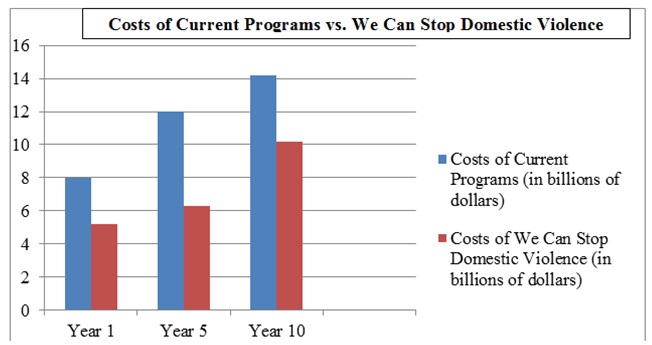Solution
We Can Stop Domestic Violence
To address the problem of domestic violence, it is necessary to propose a complex program as a response to this social issue. “We Can Stop Domestic Violence” can be viewed as more successful than other initiatives because, firstly, it is oriented to providing different types of support for victims of violence at home. Victims will be provided with assistance not only in shelters but also after leaving them (Sharma, 2015). Persons requiring help will also be provided with legal consultation regarding their case.
Distinguishing the Solution
Although there are many federal and state-based initiatives to protect victims of domestic violence, the proposed solution is unique in its attempt to combine all successful strategies to cope with the issue. Researchers support the effectiveness of shelters, hot lines, and counseling for victims of domestic violence, but many individuals do not use these resources as a complex (Kalunta-Crumpton, 2017). Standard initiatives lack the provision of required support after offering immediate assistance. This program provides care and educational and career resources for victims after resolving critical issues.
Major Steps
The program should be realized by a non-profit organization supported by the federal, state, and local governments. Offices and shelters should be opened in each city of the country. The first step is to start cooperation with existing organizations addressing domestic violence and receive state funding. All resources shared under existing programs should be accumulated in the context of creating a complex response to the problem as a result of designing a unified program supported and sponsored by the government and charity organizations. The second step is associated with determining services to offer: hot lines, shelters, medical assistance, counseling and psychological assistance, education, career options, and social adaptation (Miller, McCaw, Humphreys, & Mitchell, 2015). Other steps should be associated with implementing the program at the local level.
Deliverables
Potential outcomes of the solution will include decreases in numbers of individuals who continue living with their abusers without asking for help. In addition, more abusers will be identified as a result of this program, and the safety of their victims will be guaranteed (Abraham & Tastsoglou, 2016). Furthermore, victims of domestic violence will receive resources to start a new life without continuing unhealthy relationships with their abusers.
Benefits
Cost-Benefit Analysis
A complex approach to organizing the program to address domestic violence will have significant benefits for states. The combined efforts of federal, state, and local authorities will lead to decreasing time and energy required for creating separate shelters and initiatives to protect victims’ interests. Furthermore, less money will be necessary to organize one widely supported system of providing care for victims of domestic violence in all regions of the United States (Figure 1; Johnson, 2015).

Resources
To realize this program, it is necessary to determine what existing organizations will cooperate in the context of the initiative and provide their materials. It is important to involve healthcare providers, legal advisers, and social workers in realizing this project. Furthermore, it is also necessary to determine what specific facilities in communities can be used as shelters and offices in the context of this program.
Conclusion
The problem of domestic violence can be addressed only when a complex approach is provided at the national level. The reason is that many different resources are required in order to address multiple social and cultural aspects that lead to abuse at home. Domestic violence is associated with causing psychological and physical harm to individuals, and much attention should be paid to overcoming this issue.
The next steps for coping with domestic violence at community levels are associated with the participation in organizing shelters. “We Can Stop Domestic Violence” actively accepts any assistance of volunteers at all stages of the project realization. It is important to note that one should use the following e-mail to receive more information regarding the program and register for the participation in the project: wecanstopdomesticviolence@gmail.com.
References
Abraham, M., & Tastsoglou, E. (2016). Addressing domestic violence in Canada and the United States: The uneasy co-habitation of women and the state. Current Sociology, 64(4), 568-585.
Johnson, M. E. (2015). Changing course in the anti-domestic violence legal movement: From safety to security. Villanova Law Review, 60, 145-202.
Kalunta-Crumpton, A. (2017). Attitudes and solutions toward intimate partner violence: Immigrant Nigerian women speak. Criminology & Criminal Justice, 17(1), 3-21.
Miller, E., McCaw, B., Humphreys, B. L., & Mitchell, C. (2015). Integrating intimate partner violence assessment and intervention into healthcare in the United States: A systems approach. Journal of Women’s Health, 24(1), 92-99.
Sharma, I. (2015). Violence against women: Where are the solutions? Indian Journal of Psychiatry, 57(2), 131-139.